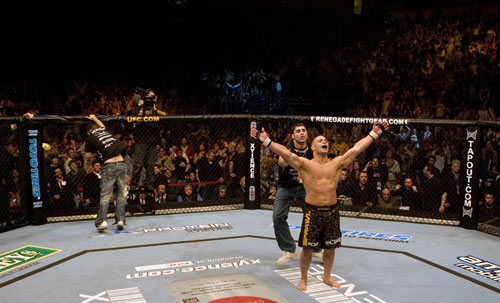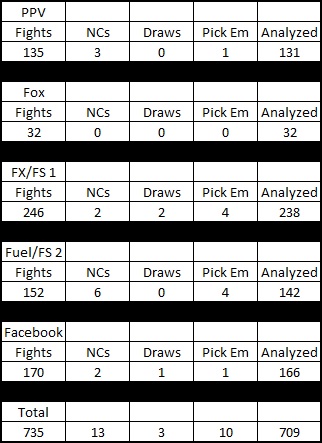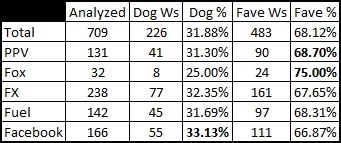 From February 15th to March 23rd – a span of 37 days – there are currently 67 UFC bouts scheduled to take place. That number is likely to change due to some late additions or last-minute cancellations, but the bigger point of emphasis is that the world’s biggest MMA promotion is about to put on a truckload of fights across various platforms in the near future. That last bit piqued my interest, as the (main) cards of these events are set to have an equal distribution across Pay-Per-View, Fox Sports 1 and UFC Fight Pass. The actual number of fights leans heavily towards Fight Pass, which makes sense given that the organization is trying to entice fans to put their money down on the platform. As usual, it wasn’t the business end of the equation which I found compelling, but a much more selfish notion: betting. At UFC 169 I had placed five bets prior to the card. Three of those bets were moneyline plays on the undercard, the fourth was an undercard parlay, and the fifth was a 5-team round robin which included three fighters from the lower portion of the event. I had zero bets hinging on the outcome of the fights that we are normally accustomed to having the most information for. The night turned out pretty well too, all four of those undercard bets cashed – two as straight underdogs – and it got me thinking about how well we perceive the read we have on fights as bettors from the top to the bottom of the card. Are upsets any more likely at the beginning of a card than the end? Is there more value in undercard lines or main card lines? As I’m ought to do, I decided to find the answers to these questions. Luckily, with the UFC’s move over to the Fox family of channels at the start of 2012 (I included the UFC on Fox 1 card as well) there has been a clear delineation of the company’s product. The best fights find their way to either PPV or Fox, FX and now Fox Sports 1 fall next in line, Fuel TV (now Fox Sports 2) is after that, and Facebook, et al. (Fight Pass) primarily gets the dregs. There were 737 UFC fights put on across 2012 and 2013, and all but two were aired on one of these platforms. Sorry Chris Camozzi/Dustin Jacoby and Shawn Jordan/Oli Thompson, but you were the only bouts not worthy of any sort of exposure. Among the 735 that did air live, the FX/FS 1 combo led the way with 246 bouts, Facebook/Fight Pass (FB/FP) was home to 170, Fuel/FS 2 held 152, fans only had to pay for 135 on PPV, and the remaining 32 were shown on Fox. The small Fox sample size causes it to be an outlier in some of the later numbers, but not by a huge margin. Within those 735 bouts, 13 had a final result of a No Contest, 3 were draws, and 10 were pick em (as per Several Bookmakers) when the lines closed. Those 26 fights were removed from the analysis as they will not reveal any information about upsets, leaving us with 709 results to analyze.
From February 15th to March 23rd – a span of 37 days – there are currently 67 UFC bouts scheduled to take place. That number is likely to change due to some late additions or last-minute cancellations, but the bigger point of emphasis is that the world’s biggest MMA promotion is about to put on a truckload of fights across various platforms in the near future. That last bit piqued my interest, as the (main) cards of these events are set to have an equal distribution across Pay-Per-View, Fox Sports 1 and UFC Fight Pass. The actual number of fights leans heavily towards Fight Pass, which makes sense given that the organization is trying to entice fans to put their money down on the platform. As usual, it wasn’t the business end of the equation which I found compelling, but a much more selfish notion: betting. At UFC 169 I had placed five bets prior to the card. Three of those bets were moneyline plays on the undercard, the fourth was an undercard parlay, and the fifth was a 5-team round robin which included three fighters from the lower portion of the event. I had zero bets hinging on the outcome of the fights that we are normally accustomed to having the most information for. The night turned out pretty well too, all four of those undercard bets cashed – two as straight underdogs – and it got me thinking about how well we perceive the read we have on fights as bettors from the top to the bottom of the card. Are upsets any more likely at the beginning of a card than the end? Is there more value in undercard lines or main card lines? As I’m ought to do, I decided to find the answers to these questions. Luckily, with the UFC’s move over to the Fox family of channels at the start of 2012 (I included the UFC on Fox 1 card as well) there has been a clear delineation of the company’s product. The best fights find their way to either PPV or Fox, FX and now Fox Sports 1 fall next in line, Fuel TV (now Fox Sports 2) is after that, and Facebook, et al. (Fight Pass) primarily gets the dregs. There were 737 UFC fights put on across 2012 and 2013, and all but two were aired on one of these platforms. Sorry Chris Camozzi/Dustin Jacoby and Shawn Jordan/Oli Thompson, but you were the only bouts not worthy of any sort of exposure. Among the 735 that did air live, the FX/FS 1 combo led the way with 246 bouts, Facebook/Fight Pass (FB/FP) was home to 170, Fuel/FS 2 held 152, fans only had to pay for 135 on PPV, and the remaining 32 were shown on Fox. The small Fox sample size causes it to be an outlier in some of the later numbers, but not by a huge margin. Within those 735 bouts, 13 had a final result of a No Contest, 3 were draws, and 10 were pick em (as per Several Bookmakers) when the lines closed. Those 26 fights were removed from the analysis as they will not reveal any information about upsets, leaving us with 709 results to analyze.
Of those 709 analyzed fights, favorites picked up the win 483 times, for a 68.12% winning percentage. Based on the bouts excluded, that means underdogs won 226 times (31.88%). My first reaction to those numbers was, “Why do I even bother picking underdogs? Most people would kill for 68% accuracy on their picks.” Once I got past the initial surprise of how often favorites actually win, I decided to look at how often fights were expected to play out each way. While doing this I’m glad I had a flashback to grade 10 business class and remembered how to use “IF” functions on Excel, otherwise my laptop may have ended up out a window halfway through the process. The final result was equally as shocking (and a bit frustrating, given that I was looking for a trend that presented some value). Based on the closing odds at Several Bookmakers, favorites were expected to win 483.18 fights. Yep. Through two full years, and over 700 fights, oddsmakers were off by 0.18 measly fights when predicting how often favorites would win. I think they might know what they’re talking about. On the other side, underdogs underperformed slightly, as they were expected to win 239.70 times and only won 226. Of course, these two numbers add up to more than the 709 analyzed fights, and that overage is about 1.96% which accounts for the juice we pay as bettors. So we’ve got our baselines. Favorites win 68.12% of the time and underdogs 31.88%. Favorites are expected to win on 68.15% of occasions, and underdogs should come through 33.81% of the time. Now to get to the meat of the issue. The next figure has the winning percentages for favorites and underdogs broken down by platform.
Aside from the limited numbers available for Fox fights, there is very little variance here. Upsets occur most frequently on the FB/FP portion of cards, which is what I initially anticipated, however I expected the difference to be more significant than it ended up being. FB/FP fights end in upsets 0.78% more often than any other platform and 1.25% more than the average for all UFC fights. Even carried across all 700+ fights, this wouldn’t change the figures greatly. On the other side of the equation, upsets happen least frequently in PPV fights. Well, actually it’s the Fox fights, but blah, blah, blah sample size yada, yada, yada. I think both numbers are telling in that we (and oddsmakers) should have the best reads on the biggest fights, and poorer reads on less established and experienced fighters. I simply expected the gap to be much wider between the two. Now that we’ve got the raw data for wins and losses, how do these numbers compare to the staggering accuracy of the betting lines overall?
Well now we’ve got a bit of a twist. While favorites win at the highest percentage in PPV fights and underdogs win most often on FB/FP, both are expected to do exactly that. In fact, favorites are expected to win 71.16% of the time in PPV fights, while lines say that underdogs should win 35.58% of the time when the fights take place on FB/FP. When these numbers are factored into the actual performance, underdogs actual perform the best (relative to their betting odds) on main cards, while the same goes for favorites on FB/FP. That was unexpected, to say the least. It seems that our preconceptions in regards to knowing more about main card fighters and less about prelim fighters tend to have us overvalue them when placed in their respective favorite or underdog position. Still, the variance in all these numbers is extremely low. Underdogs outperforming their odds by 1.56% on PPV cards and favorites overperforming by 1.02% on FB/FP aren’t numbers that are going to change your world when it comes to betting on MMA. In fact, for once I have to say that these results really don’t provide any sort of marked trend that can help when breaking down fights. There are going to be spots that present value all over the card, so as long as you’re willing to do the research on the fighters you don’t know as well (yet), there’s money to be made. If you had to focus on one cross-section of fighters however, these numbers would suggest fading the underdogs on FB/FP and FX/FS 1 is the best route, although I find it hard to imagine any tangible long-term success arising from such a strategy. Sadly, the answer when talking about the frequency of upsets for UFC fights on different platforms is the annoying cliche that “anything can happen in MMA”. Upsets can happen in the biggest fights on PPV, or the “meaningless” opener on Fight Pass, it’s all about being on the right side when it does take place.


